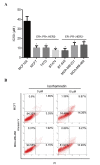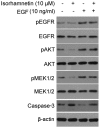Isorhamnetin inhibits cell proliferation and induces apoptosis in breast cancer via Akt and mitogen‑activated protein kinase kinase signaling pathways
- PMID: 26502751
- PMCID: PMC4626180
- DOI: 10.3892/mmr.2015.4269
Isorhamnetin inhibits cell proliferation and induces apoptosis in breast cancer via Akt and mitogen‑activated protein kinase kinase signaling pathways
Abstract
Breast cancer is the most common cause of female cancer-associated mortality. Although treatment options, including chemotherapy, radiotherapy and surgery have led to a decline in the mortality rates associated with breast cancer, drug resistance remains one of the predominant causes for poor prognosis and high recurrence rates. The present study investigated the potential effects of the natural product, isorhamnetin on breast cancer, and examined the effects of isorhamnetin on the Akt/mammalian target of rapamycin (mTOR) and the mitogen-activated protein kinase (MAPK)/MAPK kinase (MEK) signaling cascades, which are two important signaling pathways for endocrine therapy resistance in breast cancer. The results of the present study indicate that isorhamnetin inhibits cell proliferation and induces cell apoptosis. In addition, isorhamnetin was observed to inhibit the Akt/mTOR and the MEK/extracellular signal-regulated kinase phosphorylation cascades. The inhibition of these two signaling pathways was attenuated by the two Akt and MEK1 inhibitors, but not by the nuclear factor-κB inhibitor. Furthermore, epidermal growth factor inhibited the effects of isorhamnetin via activation of the Akt and MEK signaling pathways. These results indicate that isorhamnetin exhibits antitumor effects in breast cancer, which are mediated by the Akt and MEK signaling pathways.
Figures





References
-
- American Cancer Society . Cancer Facts & Figures 2013. American Cancer Society; Atlanta: 2013.
Publication types
MeSH terms
Substances
LinkOut - more resources
Full Text Sources
Other Literature Sources
Medical
Miscellaneous

